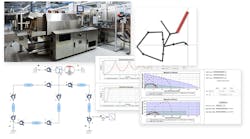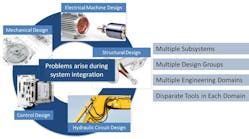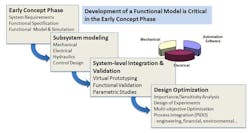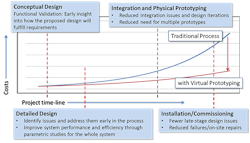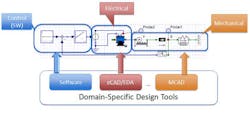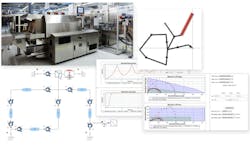This file type includes high resolution graphics and schematics when applicable.
Many engineering organizations face major challenges when designing and delivering new products that are dynamic in nature. One of the most significant is the discovery of key, often basic, design issues very late in the development cycle that introduce unbudgeted costs and delays into the project. These delays often cause projects to overrun significantly, especially when design issues are discovered during the prototyping or integration stages, and there’s real hardware involved. Even worse is when the problems are discovered after a system has been commissioned and installed. Such unforeseen weakness can result in expensive on-site service calls, loss of production, and unhappy customers, leading to extremely expensive projects that hurt the company’s bottom line.
Many of these issues come about because several design groups take part in the process of architecting a complex system. Each is focused on the development of one subsystem, using dedicated tools and methods to determine if their design will comply with the specifications for that subsystem. Often times, though, it’s only when all of the subsystems are integrated during prototyping, or even final assembly, that serious issues rear their heads.
This is why many engineering organizations are turning to system-level modeling to develop “virtual” prototypes of their systems. Virtual prototyping holds the promise of managing these challenges by integrating all design information, such as requirements, functional specifications, costs etc., in reusable objects, representing individual components, subsystems, and, ultimately, the complete system. With a model of the complete system in one environment, engineers can see how all of the individual subsystems work together, identify weaknesses in the design, and make corrections earlier in the development cycle.
Model-Driven Innovation
Using an interdisciplinary development platform enables designers to evaluate mechanical, electrical, hydraulic, or pneumatic subsystem designs jointly, in a virtual prototype, long before any physical prototyping or testing is possible. And, the emergence of optimization tools that can integrate models and analyses from many different sources now allows designers to yield optimal design parameters much faster and with greater rigor than was possible before. Finally, the ability to capture knowledge from the design of components and store these in a virtual object library enables designers to reuse this knowledge in other projects.
We call this process Model-Driven Innovation. It’s the ability to integrate functional models of components, subsystems, and complete products in a readily reusable manner, thus allowing companies to accelerate the development of complex engineered products while reducing project risk and costs.
The Model-Driven Innovation process helps product development in several ways through the use of virtual prototypes within the design process. During the initial conceptual stages, engineers can gain early insight into how the proposed design will fulfill the requirements for the system, or the subsystem, they’re working on. By building a functional model that captures the system’s dynamic behavior, lots of design decisions can be made based on investigations into how the system will respond to various “what-if” scenarios, thereby increasing confidence that the design is valid.
As the design evolves—and this invariably becomes an iterative process as more information is acquired—it is easy to incorporate any changes into the functional model to assess how they affect the complete system. Addressing any issues that come out of these studies will ensure that they won’t turn into costly problems later on.
Dynamic-Load Analysis
One area that particularly benefits from the Model Driven Innovation approach is the analysis of dynamic loads. In machines with complex mechanisms, it can be a challenge to determine the transient loads caused by the changing inertias of the mechanism. Getting a handle on these loads helps avoid overloading the actuators and reduces costs when choosing components for design.
For example, model-driven software tools allow dynamic analysis of the mechanism, making it possible to show that the transient loads due to the mechanism’s inertia exceed the safe limits of the motor. This proved to one company why it was having a problem with actuators overheating in a complex manufacturing machine. It was missed because the designer could only perform steady-state loading analyses with the previous software.
After identifying the problem, it was possible to develop a mathematical tool to define a speed profile that would slow the mechanism during the peak inertial loads, thus reducing the load on the motor to within safe limits. In this way, instead of a costly refit of a larger motor in the machine, the client was able to address the problem with a simple change to the controller. The company has since employed these techniques in the design of a new machine, which has led to 100% reliability and zero costs in on-site repairs.
The Model-Driven Innovation approach, and its emphasis on employing virtual prototyping at the system level, is an invaluable technique when designing complex, dynamic machines. By using Model-Driven tools, engineers can detect, and correct, problems that arise due to the interactions between different subsystems—long before the system-integration and physical-prototyping stages. Early detection means problems can be fixed at considerably less cost, and it helps avoid project delays. In addition, with access to the underlying mathematics, systems can be analyzed, and designs validated and improved, during the development process. By employing this approach, machine design companies can reduce development risks, develop better products, and get to market faster.
This file type includes high resolution graphics and schematics when applicable.
